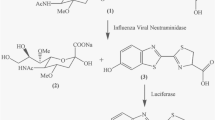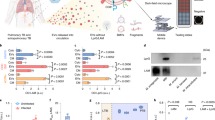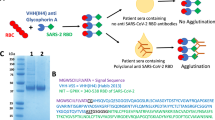Abstract
We describe an ultrasensitive immunoassay for detecting biotoxins that uses a liposome with encapsulated DNA reporters, and ganglioside receptors embedded in the bilayer, as the detection reagent. After immobilization of the target biotoxin by a capture antibody and co-binding of the detection reagent, the liposomes are ruptured to release the reporters, which are quantified by real-time polymerase chain reaction. The new assays for cholera and botulinum toxins are several orders of magnitude more sensitive than current detection methods. A single 96-well microtiter plate can analyze ∼20 specimens, including calibration standards and controls, with all measurements conducted in triplicate. Using pre-coated and blocked microtiter plates, and pre-prepared liposome reagents, a liposome polymerase chain reaction assay can be carried out in about 6 h.
This is a preview of subscription content, access via your institution
Access options
Subscribe to this journal
Receive 12 print issues and online access
$259.00 per year
only $21.58 per issue
Buy this article
- Purchase on Springer Link
- Instant access to full article PDF
Prices may be subject to local taxes which are calculated during checkout



Similar content being viewed by others
References
Gill, D.M. Bacterial toxins: a table of lethal amounts. Microbiol. Rev. 46, 86–94 (1982).
Sano, T., Smith, C.L. & Cantor, C.R. Immuno-PCR: very sensitive antigen detection by means of specific antibody-DNA conjugates. Science 258, 120–122 (1992).
Hendrickson, E.R., Truby, T.M., Joerger, R.D., Majarian, W.R. & Ebersole, R.C. High sensitivity multianalyte immunoassay using covalent DNA-labeled antibodies and polymerase chain reaction. Nucleic Acids Res. 23, 522–529 (1995).
Mason, J.T., Xu, L., Sheng, Z.M. & O'Leary, T.J. A liposome-PCR assay for the ultrasensitive detection of biological toxins. Nat. Biotechnol. 24, 555–557 (2006).
Chao, H.Y., Wang, Y.C., Tang, S.S. & Liu, H.W. A highly sensitive immuno-polymerase chain reaction assay for Clostridium botulinum neurotoxin type A. Toxicon 43, 27–34 (2004).
Ahn-Yoon, S., DeCory, T.R., Baeumner, A.J. & Durst, R.A. Ganglioside-liposome immunoassay for the ultrasensitive detection of cholera toxin. Anal. Chem. 75, 2256–2261 (2003).
Sharma, S.K. & Whiting, R.C. Methods for detection of Clostridium botulinum toxin in foods. J. Food Prot. 68, 1256–1263 (2005).
Singh, A.K., Harrison, S.H. & Schoeniger, J.S. Gangliosides as receptors for biological toxins: development of sensitive fluoroimmunoassays using ganglioside-bearing liposomes. Anal. Chem. 72, 6019–6024 (2000).
Puu, G. An approach for analysis of protein toxins based on thin films of lipid mixtures in an optical biosensor. Anal. Chem. 73, 72–79 (2001).
Güssow, D. et al. The human β2-microglobin gene: primary structure and definition of transcriptional unit. J. Immunol. 139, 3132–3138 (1987).
Bailey, A.L. & Sullivan, S.M. Efficient encapsulation of DNA plasmids in small neutral liposomes induced by ethanol and calcium. Biochim. Biophys. Acta 1468, 239–252 (2000).
Berg, E.S. & Skaug, K. Liposome encapsulation of the internal control for whole process quality assurance of nucleic acid amplification-based assays. J. Microbiol. Methods 55, 303–309 (2003).
Eidels, L., Proia, R.L. & Hart, D.A. Membrane receptors for bacterial toxins. Microbiol. Rev. 47, 596–620 (1983).
Bustin, S.A. & Nolan, T. Data analysis and interpretation. in A-Z of Quantitative PCR (ed. Bustin, S.A.) 439–492 (International University Line, La Jolla, 2004).
McKie, A., Samuel, D., Cohen, B. & Saunders, N.A. A quantitative immuno-PCR assay for the detection of mumps-specific IgG. J. Immunol. Methods 270, 135–141 (2002).
Saunders, N.A. Quantitative real-time PCR. in Real-Time PCR: An Essential Guide (eds. Edwards, K., Logan, J. & Saunders, N.) 103–123 (Horizon Bioscience, Norfolk, UK, 2004).
Huelseweh, B., Ehricht, R. & Marschall, H.-J. A simple and rapid protein array based method for the simultaneous detection of biowarfare agents. Proteomics 6, 2972–2981 (2006).
Monnard, P.-A., Oberholzer, T. & Luisi, P. Entrapment of nucleic acids in liposomes. Biochimica. et Biophysica. Acta 1329, 39–50 (1997).
Acknowledgements
This work was supported by Army Medical Research and Material Command grant DAMD17-02-1-0178.
Author information
Authors and Affiliations
Corresponding author
Ethics declarations
Competing interests
The authors declare no competing financial interests.
Rights and permissions
About this article
Cite this article
Mason, J., Xu, L., Sheng, Zm. et al. Liposome polymerase chain reaction assay for the sub-attomolar detection of cholera toxin and botulinum neurotoxin type A. Nat Protoc 1, 2003–2011 (2006). https://doi.org/10.1038/nprot.2006.331
Published:
Issue Date:
DOI: https://doi.org/10.1038/nprot.2006.331
This article is cited by
-
Detection of Protein Toxin Simulants from Contaminated Surfaces by Paper Spray Mass Spectrometry
Journal of the American Society for Mass Spectrometry (2019)
-
Immunoliposome-PCR: a generic ultrasensitive quantitative antigen detection system
Journal of Nanobiotechnology (2012)
-
Aptamer sandwich assays: human α-thrombin detection using liposome enhancement
Analytical and Bioanalytical Chemistry (2010)
-
The multiple faces of self-assembled lipidic systems
PMC Biophysics (2009)
Comments
By submitting a comment you agree to abide by our Terms and Community Guidelines. If you find something abusive or that does not comply with our terms or guidelines please flag it as inappropriate.



